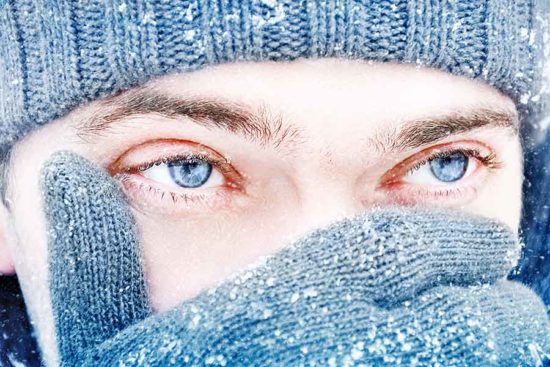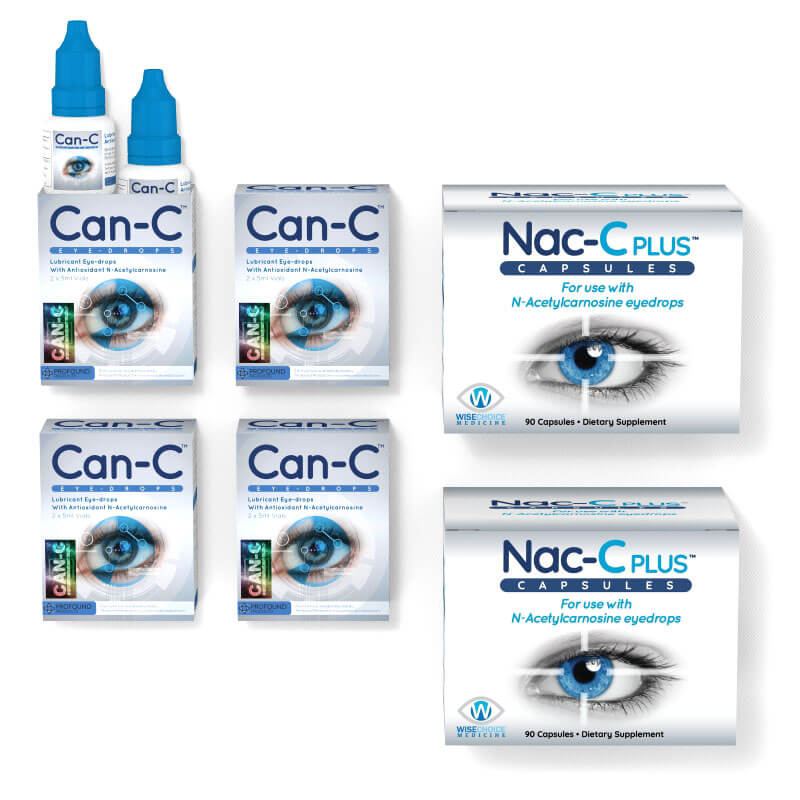March is Save Your Vision Month - click here for FREE healthy vision tips

Four tips to protect your eyes from the cold weather
Last Updated on November 7, 2022
Table of Contents
Winter season is on its way, and with it comes colder weather.
Cold weather can cause achey joints and muscles, dry out skin, and weaken our immune systems, but did you know that frigid temperatures can also impact your eye health and vision?
To get prepared for the winter months, here are four of the most common eye problems associated with cold weather, and ways you can mitigate these seasonal vision ailments.
Dryness / Redness
What happens: The most common and well-known effect of cold temperatures on the eyes, dryness occurs because cold air typically contains less moisture than warmer air. For the same reason our skin and lips dry out due to harsh weather conditions, this low humidity can cause irritation and vision changes. That irritation can lead to uncomfortable symptoms such as redness, itchiness, inflammation, and pain around the eyes.
How to fix it: Staying hydrated and keeping a humidifier in your indoor spaces can be a big help, but eye drops are your best friend when it comes to dryness. They add moisture back to the eyes and help prevent them from drying out.
Wise Choice Medicine‘s Can-C™ Eye Drops lubricate the eye while also providing nourishing eye vitamins like N-Acetyl-Carnosine (NAC) to protect your vision from damage in multiple ways. NAC has been shown in clinical studies to dramatically counter inflammation and reverse oxidation, restoring the eye’s natural ability to heal and repair itself. Can-C™ Eye Drops with NAC have been shown to support natural tear production, and their effects can be further enhanced by artificial tears from a cheap preservative-free lubricating eye drop, used 5-10 minutes before applying Can-C Eye Drops (and throughout the day). Uptake of the N-Acetyl-Carnosine ingredient in Can-C will be improved if the eyes are not dry and stressed at the time of application.
UV Damage / Light Sensitivity
What happens: Sunburns are more than just painful red skin and peeling blisters – overdoing sun exposure can also damage your eyes. Many people wear sunglasses through the summer and then put them away for winter, but the sun is still sending UV rays our way, and any snow on the ground actually amplifies the effects of the sun on our vision. That’s why sunburns to the eyes are especially common at higher altitudes or doing winter activities that can cause snow blindness from all of the UV light reflecting off of the ground. Anyone participating in winter sports should be especially careful about protecting their vision, as they are the most vulnerable. If you’re wondering how to tell if your eyes may have suffered UV damage, you would notice an increase in light sensitivity, accompanied by increased blinking, redness, itching, tenderness, or discomfort.
How to fix it: In this case, the best fix is prevention. Any time you plan to be in the sun for an extended period, wear sunglasses (or ski goggles for winter sports) that have lenses with UV protection that are certified UV400 in order to ensure they block enough full-spectrum UV light to preserve your vision health.
Wearing a wide-brimmed hat with at least a 3′′ wide brim can also significantly reduces sun exposure and offers eye protection. Hats provide a long-lasting sun barrier that protects your skin and eyes from the sun, unlike sunscreen which needs to be reapplied every two hours. The Skin Cancer Foundation advises wearing hats made of dark-colored, tightly woven materials like canvas, denim, wool, or synthetic fibers. If you hold the fabric up to the light and can see light through it, the safety level is insufficient. Try to choose hats with UV protection built in, and a UV Protective Factor (UPF) of at least 30.
If you are already experiencing eye sunburn symptoms, make an appointment with an optometrist, as treatment can relieve some of the pain and discomfort, and decrease the risk of permanent damage with long-term ailments like vision loss or macular degeneration.
Watery Eyes
What happens: While many people experience dry eyes in the winter, the opposite effect can often be a problem as well. In fact, excessive tears is one of the primary symptoms of Dry Eye Syndrome. Due to the dry, cold winter air, (especially when there are cold winter winds), our eyes can over-correct and increase watery tear production as a defense mechanism to compensate for the drying effects of the environment. This is often uncomfortable, and can even obscure our vision by causing blurriness. However, these watery tears don’t even alleviate the underlying dry eye problem because they get wiped away or evaporate too quickly.
How to fix it: Just like with UV damage, protecting your eyes from the elements in the first place is the best way to treat excess tear production. Wearing glasses or goggles and keeping your body hydrated whenever you know you’ll be in a cold, windy outdoor environment can be hugely effective at reducing or even eliminating excess tear production caused by cold weather.
Supplementation and specialized eye drops can also provide immediate and long-term relief for dry or watery eyes. Research has shown that oral consumption of specific amino acids can reduce inflammation and optimize the eyes’ healing response. Nac-C Plus™ capsules contain five powerful amino acids, and were designed to be taken with Can-C eye drops to accelerate healing, improve overall outcomes including dry eye relief, and restore health to the eyes.
Vision Changes
What happens: The previous ailments demonstrated how increased light or decreased moisture can cause many of our wintertime eye health issues, but the cold weather itself can actually cause eye conditions too. The blood vessels in and around the eyes constrict when exposed to extremely low temperatures, which can immediately affect vision and result in blurriness or double vision. When you spend a lot of time outside in temperatures well below freezing, you increase your risk of these changes occurring.
How to fix it: If you notice your vision starting to change while you’re outside in the cold, get as close to a warm place as you can. After around 30 minutes, if your normal vision still hasn’t returned, get medical help. Treatments like medicated eye drops, administered by an optometrist, can help the blood vessels in your eye expand back to their normal size.
Consult an optometrist if you experience any of the aforementioned seasonal issues affecting the health of your eyes. While some of these conditions will improve naturally as the weather warms, others could worsen and even become dangerous if left untreated.
Wise Choice Medicine’s ocular support product line is designed to boost and improve eye health by supporting the eyes’ natural ability to recover from stress factors such as UV damage and cold, dry weather.

Wise Choice Medicine offers a 90-Day vision support program that includes a 3-month supply of both Can-C™ Eye Drops and Nac-C Plus™ Capsules. Can-C™ Eye Drops were created to safely and effectively restore L-Carnosine levels in the eyes, which can reverse and repair a variety of ocular diseases. Nac-C Plus™ capsules enhance and prolong the effects of Can-C eye drops inside the eye. For individuals who want their improvements to happen more rapidly, the combination of these two powerful products will be highly beneficial. This potent combination limits free radicals and reverses oxidation, speeding up the healing reactions within the eye.
For more information about combining Can-C™ eye drops and Nac-C Plus™ capsules, click here.

